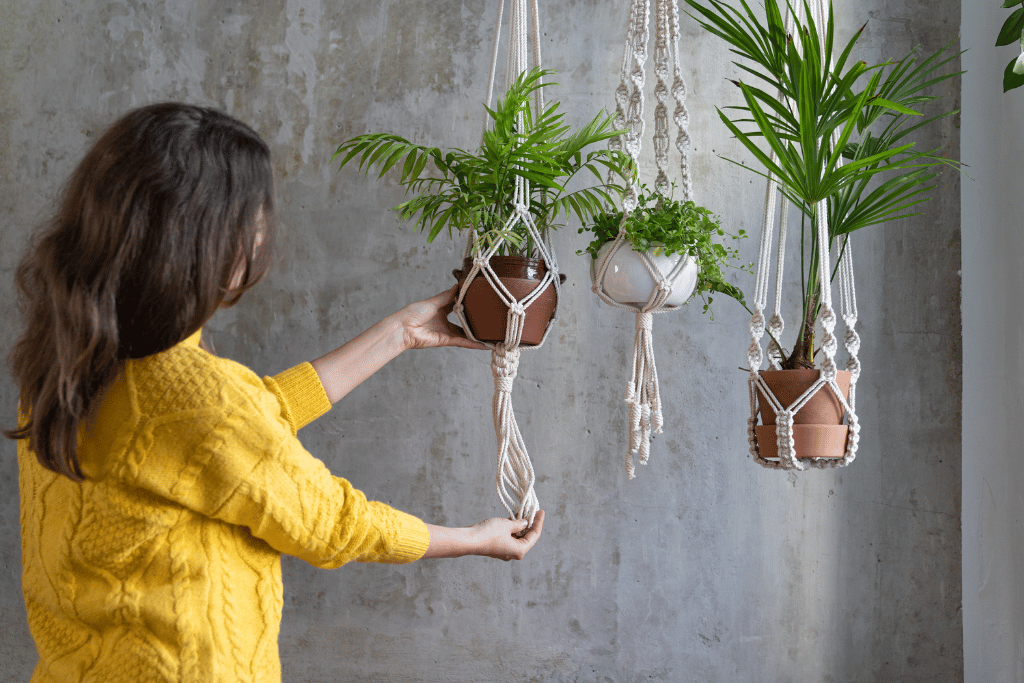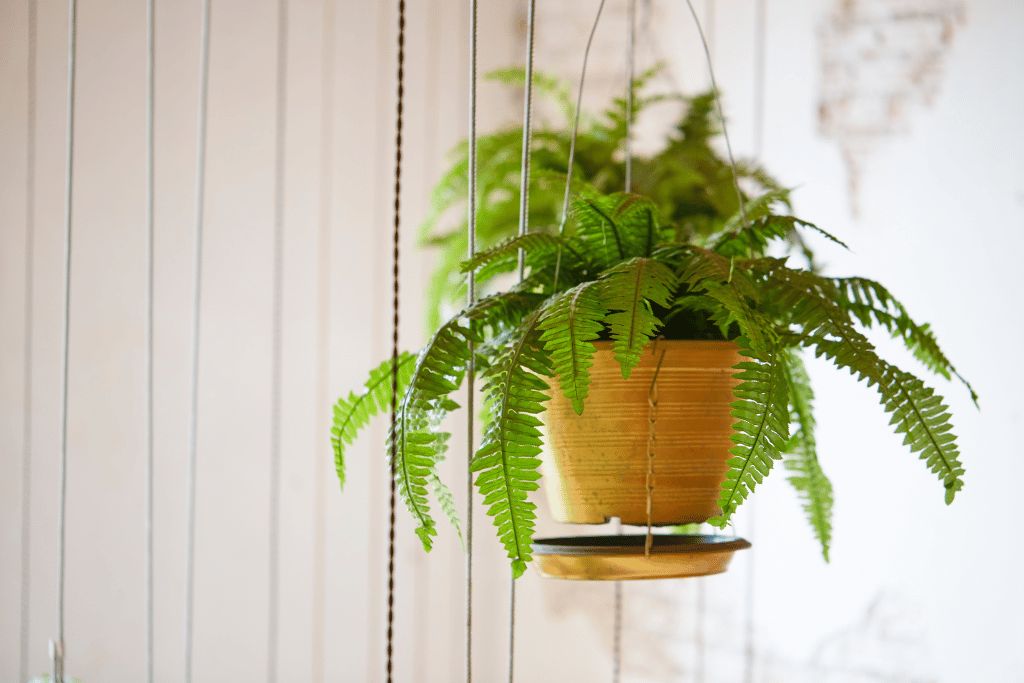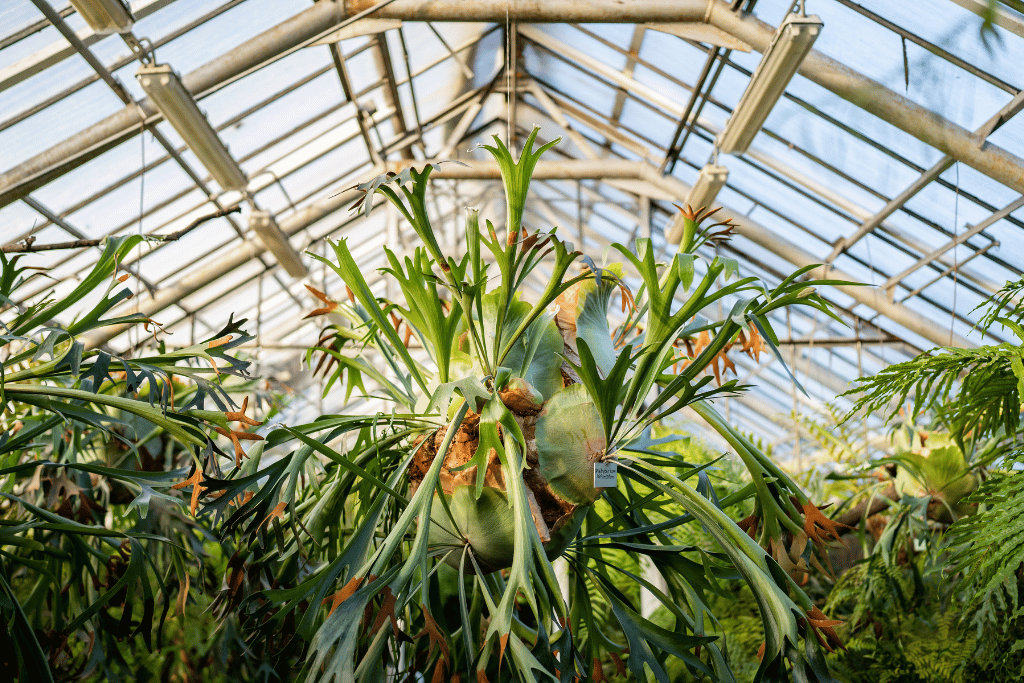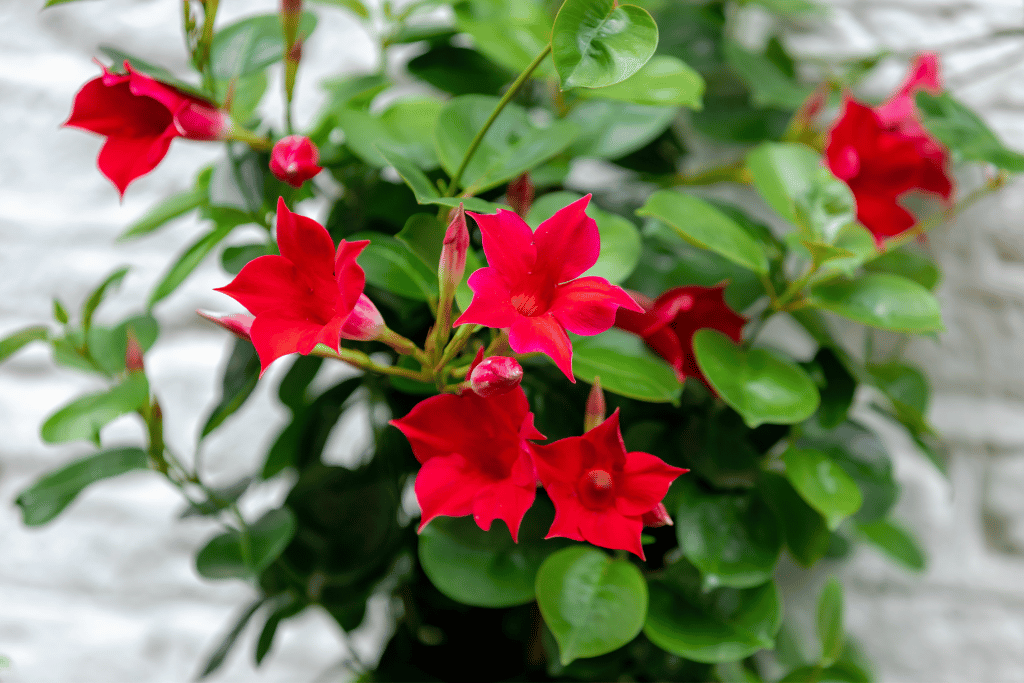
If you’re looking to add some glamor and greenery to your room but only have limited amounts of natural light, hanging plants can be a great solution to your problem. Adding beauty and texture to your space, they can also improve air quality and boost your mood! Not all plants will thrive in low-light conditions, but in this article, we’ll explore some of the best options you have for hanging plants in low-light environments.

1. Pothos
Pothos, also known as Devil’s Ivy, is one of the most popular and classic houseplants, which are easy to care for and can tolerate a wide range of light conditions, including low light. They have long and trailing stems which can reach up to 10 feet in length, which makes them a perfect candidate for hanging baskets. They can come in a variety of colors, including gold, green and variegated varieties. Well-draining soil is the best option for pothos, and they should only be watered when their top inch of soil is dry. I like to test this by simply poking my finger an inch deep into the soil to check for moisture. It’s best to avoid overwatering and underwatering with your houseplants, as this can lead to a variety of problems. They can also be grown in the water, though, which makes them a great choice for hanging in a vase or bottle.

2. Spider Plant
Spider plants are also another one of the most popular and classic houseplants most people own. They’re well-suited for low light conditions, with long, arching stems which have small white flowers that eventually turn into baby spider plants. These baby spider plants can be potted and grown to form new spider plants, which makes them a great option to add more to your collection. Spider plants like moist and well-draining soil – they should be watered regularly.

3. English Ivy
English Ivy is a popular trailing plant which is amazing for adding a touch of elegance to any space. They prefer to be kept in low to medium light conditions, and they are able to be grown in hanging baskets or trained to climb up trellises, walls or other support structures. English Ivy prefers well-draining soil and should be watered regularly but not overwatered, as this can lead to root rot.

4. Philodendron
Philodendrons are one of the most well-known families of plants which come in a wide variety of shapes and sizes. Many philodendrons, such as the heartleaf philodendron, are well-suited for low-light conditions. They have long and trailing vines which can reach several feet in length, which makes them ideal for hanging baskets. Philodendrons prefer well-draining soil, only being watered when the top inch of their soil is dry.

5. ZZ Plant
Known as the ZZ plant or Zamioculcas zamiifolia, the ZZ plant is a popular houseplant which is well-suited and adapted for low light conditions. They have dark green and glossy leaves, which are able to tolerate a wide range of light conditions, including low light. They prefer well-draining soil, and they should be watered when the top inch of soil is dry.

6. String of Pearls
A unique trailing plant that has long and thin stems with small, round leaves that resemble pearls – the string of pearls is a beautiful houseplant which I personally love. They prefer bright and indirect light, but they can tolerate low-light conditions. The string of Pearls prefer well-draining soil, and they should be watered less frequently as they are quite susceptible to overwatering.

7. Golden Pothos
Known as Scindapsus aureus or golden pothos, it’s a trailing plant with heart-shaped leaves, variegated with yellow or white. These are easy to care for, being able to tolerate low light conditions, therefore, making them a popular choice for hanging baskets. Golden Pothos prefer well-draining soil, and they should be watered when the top inch of their soil is dry, like many others on this list.

8. Chinese Evergreen
The Chinese Evergreen, also known as Aglaonema, is a popular houseplant well suited for low light conditions. They have dark green leaves with silver or white markings, which makes them a beautiful addition to any space. They prefer well-draining soil and should be watered when the top inch of soil is dry.

9. Boston Fern
The Boston Fern is a popular houseplant which is a favorite of homeowners for many generations. They have long and graceful fronds which can reach up to three feet in length, making them well-suited for cultivation in hanging baskets. Boston Ferns prefer bright and indirect light, but they can tolerate low light conditions too. They prefer well-draining soil and should be watered regularly to keep the soil on the moist side.

10. Nerve Plant
Known as Fittonia or the nerve plant, these are a unique houseplant with striking foliage guaranteed to blow you away. They have dark green leaves with pink or white veins, making them an unusual addition to your houseplant collection. Nerve plants prefer low to medium light, and they should be watered regularly to keep the soil moist.

11. Arrowhead Plant
Known also as Syngoniums, the arrowhead plant is a popular houseplant which is well-suited for low light conditions. They have arrow-shaped leaves, which can range in color from green to variegated shades of pink, red and white. Arrowhead plants prefer well-draining soil, and they should be watered when the top inch of the soil is dry.

12. Prayer Plant
The Prayer Plant, also known as Maranta, is a popular houseplant with lush and gorgeous foliage. They have green leaves with striking red veins, and they close their leaves at night, which gives them their name. Prayer plants prefer low to medium light, and they should be watered regularly to keep the soil moist.

13. Cast Iron Plant
Cast Iron Plants, which are also known as Aspidistra, are a hardy houseplant which can tolerate low light conditions. They have long and dark green leaves, which add a sense of exoticness to any room. They prefer well-draining soil and should be watered when the top inch of soil is dry.

14. Peace Lily
Peace Lilies, also known as Spathiphyllum, are beautiful houseplants which can thrive in low to medium-light conditions. They have large and glossy leaves with white flowers that can bloom throughout the year. They prefer well-draining soil and should be watered when the top inch of soil is dry.

15. Tradescantia
Tradescantia, also known as Spiderwort, are trailing plants which can add a lovely pop of color to any space. They have elongated leaves which can range in color from green to variegated shades of pink or purple. They prefer well-draining soil and should be watered when the top inch of soil is dry.

16. Staghorn Fern
Staghorn Ferns, also known as Platycerium, are unusual hanging plants which can add a touch of texture to your houseplant collection. They have large and flat fronds which resemble the antlers of a stag, which is where they get their name from. Staghorn ferns prefer well-draining soil and should be watered when the top inch of soil is dry.

Care Tips for Hanging Plants in Low Light Conditions:
- Choose the right pot: When potting your plants, it’s important that you choose a pot that has adequate drainage holes to allow excess water to escape, preventing standing water which can rot the roots of your plants. Hanging baskets are a great option for trailing plants.
- Use the right mixtures of soil: Hanging plants need well-draining soil to prevent water from sitting in the pot, which can cause root rot and lead to the growth of nasty bacteria and fungi. It would be best if you chose a potting mix that contains vermiculite or perlite.
- Fertilize regularly: Feeding plants is one of the most important things that not many people are aware of – it provides them with all the nutrients needed for growth and flowering, helping them to thrive. Hanging plants benefit from regular fertilization to promote healthy growth. It would be best if you opted for a balanced and water-soluble fertilizer, following the instructions on the packaging.
- Rotate the plant: To ensure even growth of the plant, you should rotate the plant every few weeks to make sure all sides of the plant receive equal amounts of light. If not, you’ll find that one side of the plant seems to be growing a lot stronger than the other side.
- Water properly: Check the soil moisture level regularly and water only when the top inch of soil is dry – it’s best not to stick to a watering schedule as the water demand of your plants can change depending on factors such as light intensity or the changing seasons. Your plant will likely have a lower water demand as it comes to the cooler months in autumn and winter, and it may go dormant. In the spring and summer, you’ll find that the watering demand increases quite fast, though.
- Humidity: Many hanging plants prefer humid conditions, so you should consider using something such as a humidifier, misting the leaves occasionally or using a drip tray with pebbles in.
- Temperature: Most hanging plants prefer temperatures around 15-24C (60-75F), so try not to place them near any large windows or doors with drafts.
- Pests: I like to regularly check over my plants at least once a week to keep an eye out for houseplant pests, such as mealybugs, scale insects and spider mites. These can be treated with a good insecticidal soap or neem oil, which I prefer to use as it seems to be quite effective.
- Repotting: As your hanging plants grow, they may become root-bound over time and outgrow their current pot. Repotting can help to give them more space to grow and thrive, so make sure to choose a pot that’s slightly larger than the current one and use fresh potting mix when you repot them.
- Pruning: Regular pruning will help to keep your hanging plants healthy and full – trim back any dead or yellowing leaves, and pinch back new growth to encourage branching.
Final Thoughts
With this list of hanging plants that thrive in low conditions, hopefully, you should be able to find the perfect plant to add some beauty and greenery to your home. Remember – pick a pot with drainage holes, use a well-draining potting mix that’s tried and tested, water properly, fertilize regularly, rotate the plant and provide the correct amount of humidity and temperature. By following this regime and giving your plants proper care, your hanging plants can thrive in low-light conditions and bring joy to your home.
Frequently Asked Questions (FAQ)
Can any plants survive in a windowless bathroom?
This is quite a narrow category for plants to fit in, as they will need to be able to cope with both low light levels and high humidity. Therefore, some plants that would be a good choice for windowless bathrooms include Boston ferns, philodendrons, spider plants, English ivy, snake plants, peace lilies and aloe vera.
Does aloe vera need sunlight?
Yes, they do. It’s essential that you place your aloe plant in a window where it receives around a minimum of six hours of sunlight per day. Without direct and extended amounts of light, your succulent will begin to stretch and lose its compactness. You may find that over time, the plant may topple over when the stem gradually becomes weaker.
How often should aloe vera be watered?
When you water aloe vera plants, you should make sure that you are thorough when doing this, but this should be done infrequently. To stop root rot from occurring, allow the soil to dry out at least an inch or two deep between waterings. You can feel this by just poking your finger an inch deep into the soil. It would be best if you never let your aloe plant sit in water, as this can encourage root rot and the formation of nasty bacteria and fungi. Aloe vera will need watering around every three weeks and less in the winter when their water demand is lower.
Are there any low-light succulents?
If you’re an avid succulent fan, you’ll be happy to know that there are quite a few succulents which are able to tolerate low-light conditions. Some of these include; aloe, haworthia, gasteria, echeverias, rhipsalis, schlumbergera, hoya and kalanchoe. My favorite out of all of these would definitely have to be hoya due to their beautiful and unusual flowers.



